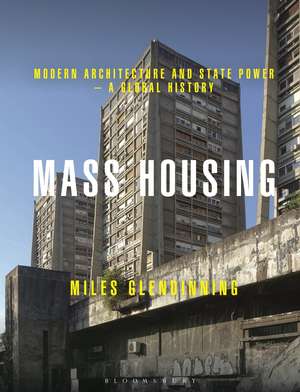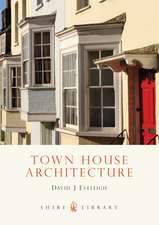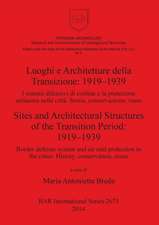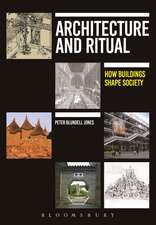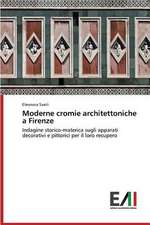Mass Housing: Modern Architecture and State Power – a Global History
Autor Miles Glendinningen Limba Engleză Paperback – 24 mar 2021
Preț: 227.92 lei
Preț vechi: 248.67 lei
-8% Nou
Puncte Express: 342
Preț estimativ în valută:
43.63€ • 47.40$ • 36.67£
43.63€ • 47.40$ • 36.67£
Carte disponibilă
Livrare economică 01-15 aprilie
Livrare express 15-21 martie pentru 113.23 lei
Preluare comenzi: 021 569.72.76
Specificații
ISBN-13: 9781474222501
ISBN-10: 1474222501
Pagini: 688
Ilustrații: 40 bw illus and 150 full colour composite pages
Dimensiuni: 189 x 246 x 36 mm
Greutate: 1.88 kg
Editura: Bloomsbury Publishing
Colecția Bloomsbury Visual Arts
Locul publicării:London, United Kingdom
ISBN-10: 1474222501
Pagini: 688
Ilustrații: 40 bw illus and 150 full colour composite pages
Dimensiuni: 189 x 246 x 36 mm
Greutate: 1.88 kg
Editura: Bloomsbury Publishing
Colecția Bloomsbury Visual Arts
Locul publicării:London, United Kingdom
Caracteristici
This book is the first to provide a comprehensive, global historical overview of the mass housing movement, as the scale and controversial character of the movement have meant that previous studies have been restricted to the national or local level
Notă biografică
Miles Glendinning is Professor of Architectural Conservation at the Edinburgh School of Architecture and Landscape Architecture, University of Edinburgh, UK.
Cuprins
List of IllustrationsAcknowledgements INTRODUCTION Cuius regio, eius religio - the multiple modernities of housingMass housing - spearhead of radical modernisationMethodological challenges and constraints: balancing narrative and geography PART A: MID 19th-CENTURY TO 1945 - The gathering storm 1. Pre-1914: The Long Mobilisation Mid 19th-century innovators and experimentsLate 19th- early 20th century ideologies: public housing and arm's length buildingThe dual market: working-class tenements and middle-class apartments in North AmericaHousing and colonialism: building for rulers or the ruled?The upsurge in emergencies: 1905-1914 2. 1914-1945 The maturing of mass housing in the age of emergencies Systematisation and individualism: the emergence of modern mass housingWorld War I: war socialism and rent controlThe Hare and the Tortoise: municipal housing in 'Red Vienna' and BritainContinental permutations in the 1920sTotalitarian housing visions in the Great DepressionDemocratic housing systems of the 1930sInterwar Latin America and the coloniesWorld War II - The globalisation of emergency PART B: 1945-1989 - The 'Three Worlds' of postwar mass housing 3. Postwar mass housing: an introductory overview First World, Second World, Third WorldInternational modernism: from global to local 4. Housing by Authority - post-war state interventions in the 'Anglosphere' Red scares, race scares - the brief heyday and long retreat of US public housingNew York City - the monumental exceptionLocal trajectories of renewal and decline Canada: government intervention and the revival of renting'Big Daddy' and mass housing in Metro TorontoNew Zealand and AustraliaCommonwealth and state: the CSHAHigh flats and slum reclamation in Victoria and New South Wales 5. Council Powers: postwar public housing in Britain and Ireland Central and municipal Postwar housing design in EnglandSlum clearance, planning and the 'land-trap' Financing and organising high flats in the 'sixties London and the English citiesScotland: the legacy of 'Red Clydeside' Island diversity: Ireland and the Channel Islands 6. France: the Trente Glorieuses of mass housing 1945-55 - A hesitant revivalSCIC, SCET and the état planificateur'Le hard french': the housing legacy of Perret1955-75: 'grands ensembles' and the industrialisation of national grandeur 7. The Low Countries - pillars of modern mass housing Socialist skyscrapers versus Catholic cottages: postwar housing in BelgiumThe Netherlands: planned housing and 'polder politics'Standardisation and galerijbouw: postwar Dutch housing design 8.Stability and Continuity: West Germany and the alpine countries Tenure-neutral building in Switzerland and AustriaWest Germany: the housing of soziale Marktwirtschaft 'Wohnungen, Wohnungen und nochmals Wohnungen' - Neue Heimat and 1950s-70s production 9. The Nordic countries - social versus individual? Building the 'Folkhem' - housing and Social Democracy in SwedenDenmark: modernisation through quiet qualityFinland, Norway and Iceland - mass housing for the individual 10. Southern Europe - social housing for kinship societies The progressive South: postwar housing in Italy and MaltaINA-Casa: the Christian Democratic housing visionLeft Turn? 1960s-70s 'comprehensive' planning in ItalyThe conservative South: postwar housing in Spain, Portugal, Greece and TurkeyConclusion: First World housing in summary 11. The USSR: Developed Socialism and Extensive Urbanism 'Quickly, Cheaply and Well' - Soviet housing under Khrushchev and BrezhnevThe curate's egg - national and local housing production in the postwar Soviet UnionOrder out of chaos? central and private-sector initiativesMonumentality and space in postwar Soviet housingSNiP and DSK - standardisation and industrialisation Taming the colossus: towards 'complexity' and 'flexibility' A brotherly mosaic - regionalist housing in the USSRTashkent - model Soviet citySoviet housing in the perestroika years 12. A quarrelsome family: the European socialist states The satellite bloc: from dissidence to decompositionThe diversity of socialist standardisationSocialist outliers: European divergences from the Soviet modelThe 'Ongoing Revolution' - self-management and monumentality in YugoslaviaNovi Beograd - epicentre of decentralismLate socialist cluster-developments across the Yugoslav republics 13. Socialist Eastern Asia: mass housing and the Sino-Soviet split Danwei: fragmentation and austerity in Chinese socialist housing From the Great Leap Forward to the Cultural Revolution: austerity and anarchy'Soviet' Asia: Mongolia and North Vietnam Building at 'Pyongyang speed': housing in Juche KoreaConclusion: Second World housing in summary14. Latin America - chameleon continent Mass housing and the politics of charismatic leadership, 1945-1964Housing as social security: pre-1964 Brazil1960s Cold-War housing politics in Latin AmericaOrder and Progress? Post-1964 housing in Brazil, Argentina and Chile 15. Echoes of empire - postwar housing in the Middle East, South Asia and Africa The Middle East: decolonisation and developmentIsrael: creating a 'new geography' through public housingIndia and South Asia: building on colonial bureaucracyCapital colonies: post-independence DelhiBombay/Mumbai and MHADA: pressure-cooker buildingSub-Saharan Africa: colonialism's last stand'Progressive' housing decolonisation in francophone AfricaDivide and rule? Segregation and mass housing in 'British' AfricaSouth Africa: segregated housing in a siege society 6. From Third World to First World: mass housing in capitalist Eastern Asia Towards the developmental state - postwar housing in Japan Housing the 'Asian Tigers''Housing Gangnam-style': South Korea's tanji revolutionHong Kong and Singapore - a study in sibling rivalryShek Kip Mei and Bukit Ho Swee: from resettlement to home-ownershipRace to the Top: HDB and HKHA architectureFirst cousin: Macau PART C: 1989 TO THE PRESENT - Retrenchment and renewal 17. Resilience and renewal: mass housing into the 21st century IntroductionThe aftermath: mass housing at bay in the former First and Second WorldsResidual mass housing in the Global South 18. Race to the top: the new Asian developmentalism TOKi and AKP TurkeyDevelopmental Eastern Asia into the 21st centuryBuilding for the 'Mass Line': social housing in 21st-century China 19. Conclusion: global and national, idealism and realpolitik Index
Recenzii
It is the great achievement of this project that it takes a truly global perspective while also stressing the distinctive differences that separate one nation from another. No serious student of modern architecture can afford to be without Glendinning's Mass Housing. It will become the standard work on the subject.
This book should find a place on the shelves of many; politicians, policy advisers, civil servants and, as an invaluable textbook for advanced students in a range of disciplines. It is lavishly illustrated with full-colour photographs and is unlikely to be superseded for many years.
Magisterial and illuminating ... Glendinning is a compelling storyteller ... Mass Housing is an extraordinary achievement.
This book will prove invaluable as a new resource for housing historians. In skilfully relating architectural form to the broader social and political contexts, it will also be insightful for academics and students in a range of disciplines and policy makers concerned with housing delivery and heritage conservation.
Both sweeping and detailed, Mass Housing is about more than massive housing or even housing for 'the masses'. It is an ambitious and broadly-comparative inquiry into the globally-felt political need to undertake such quests, revealing and illustrating surprisingly diverse architectural expressions.
This book comprehensively dismantles the caricatured view of modernist mass housing as homogenous, repetitive and ill-suited to the diversity of contemporary urban life. In its place, Miles Glendinning offers a fresh perspective on the formal inventiveness, social complexity, global reach and sheer problem-solving spirit that this architecture embodies.
This book should find a place on the shelves of many; politicians, policy advisers, civil servants and, as an invaluable textbook for advanced students in a range of disciplines. It is lavishly illustrated with full-colour photographs and is unlikely to be superseded for many years.
Magisterial and illuminating ... Glendinning is a compelling storyteller ... Mass Housing is an extraordinary achievement.
This book will prove invaluable as a new resource for housing historians. In skilfully relating architectural form to the broader social and political contexts, it will also be insightful for academics and students in a range of disciplines and policy makers concerned with housing delivery and heritage conservation.
Both sweeping and detailed, Mass Housing is about more than massive housing or even housing for 'the masses'. It is an ambitious and broadly-comparative inquiry into the globally-felt political need to undertake such quests, revealing and illustrating surprisingly diverse architectural expressions.
This book comprehensively dismantles the caricatured view of modernist mass housing as homogenous, repetitive and ill-suited to the diversity of contemporary urban life. In its place, Miles Glendinning offers a fresh perspective on the formal inventiveness, social complexity, global reach and sheer problem-solving spirit that this architecture embodies.
